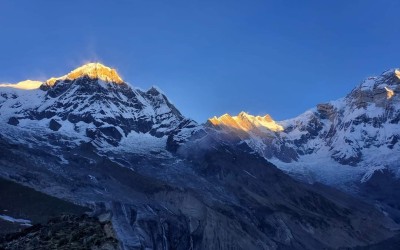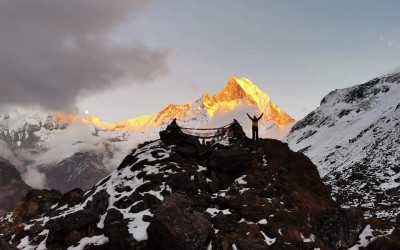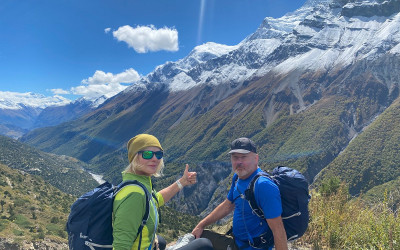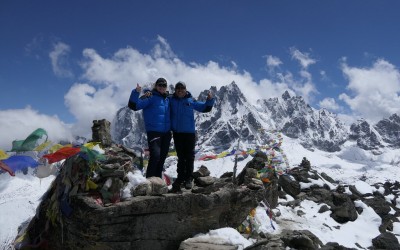Trip At Glance
-
Group Size2-15 Persons
-
Max Elevation4130 Meters
-
GradeModerate to Adventurous
-
DestinationNepal
-
TransportationFlight/Bus/Jeep
-
AccommodationTea House
-
CostContact Us
-
Trip Length08 days
-
Best MonthSpring & Autumn
-
WIFIAvailable
-
RegionAnnapuran Region
-
Trip ModeTea House
-
MealB/L/D
-
Trekking StyleTea House Trek
overview
Trip Overview
Annapurna Base Camp Short Trekking itinerary is the result of our continuous work on creating the sustainable trekking environment in Nepal. The regular trekking to the base camp of the world’s 10th tallest mountain Mt. Annapurna requires at least two weeks of holiday. The route traverses through the famous Poon Hill area nearby Ghorepani. However, this trekking package simply focuses on reaching the Annapurna Base Camp (4130 m).
There are numerous trekking routes in Nepal. Among these trekking routes, the trekking trails of Annapurna region are the most popular one. It is because of the diversity in terms of the natural resources and cultural aspects of multiethnic people. The varied landscape and the glorious chance of reaching the base camp of Mt. Annapurna add the gloss to this splendid walking trip of Nepal.
How can we reach the Annapurna Base Camp in just a week?
Annapurna Base Camp is the most popular destination for the trekkers after Everest Base Camp. Therefore, trekkers queue up to do this trekking in Nepal. Moreover, the team of Tramping Himalaya Adventures always wishes for the trekkers to enjoy the majestic mountains as well as experience the multiethnic culture.
The first phase of the trekking is similar to the regular Annapurna Base Camp Trekking itinerary. As the trail head for both styles of trekking in Annapurna region of Nepal is via Nayapul or Birethanti. Therefore, trekkers travel to Jhinu Danda via Nayapul on a jeep from Pokhara. The walking starts from this place to Chhomrong on the first day. The following day is the toughest one as there is the gentle uphill and the increase in the altitude. Enjoy the breathtaking scenery of Mt. Machhapuchhre along the way.
Annapurna Base Camp
The base camp of the world’s 10th tallest mountain Mt. Annapurna is the most serene place in the earth. People often consider the journey of Annapurna Base Camp Trek as the Annapurna Sanctuary Trek. It is because of the location of the base camp. Once you are the base camp, you will see the mountains in all sides and you will be amazed to feel dwarfed by the gigantic snowy mountains. Moreover, the time that you spend at the base camp will definitely lasts as the most momentous time of your life. Take as many pictures as possible to record the legendary event of your life. During the Annapurna Base Camp Short Trekking, trekkers will relish the time at the base camp in very short walking vacation.
Physical Fitness Requirements for Annapurna Base Camp Short Trekking
To reach the base camp of Mt. Annapurna Base Camp after just three days of walking is not ordinary. It is indeed the intrepid and arduous task. Therefore, every trekkers need to be in the utmost physical fitness level. One month prior to the trekking day, trekkers need to prepare their body. Perform various cardio vascular activities and prepare your body in such a way that you can walk continuously for about 7 – 8 hours a day in the uphill and downhill courses in a high altitude places.
Doing the short walking exercises, cycling, and some evening or morning walks can help you prepare for the trip.
Eating and Drinking Habits before Annapurna Base Camp Short Trekking
The major eating and drinking habits before Annapurna Base Camp Trekking in Nepal have to be proper. Traveling to the high altitude places is always risky. Therefore, you need to do everything possible to make it safe and secured. Avoid eating greasy and fried foods. Cholesterol increasing foods are recommended to be avoided. Also, don’t drink alcohol. The biggest factor of altitude sickness is the dehydration. Therefore, alcohol is strictly prohibited while travel uphill as it increases the chance of dehydration.
Best Time to do Annapurna Trekking
Throughout the year, trekking to the Annapurna Base Camp is possible. However, there are two seasonal windows that are regarded as the most suitable time to do trekking in Nepal. They are either spring season or autumn season. The months of March, April, May, September, October, and November are the best time do Annapurna Trekking.
Cultural Diversity in the Annapurna Base Camp Short Trek Route
In the upper section of the trekking route, there are places that are mainly for the accommodation of the trekkers. There are no densely populated settlements. However, lower section of the Annapurna Base Camp Short Trek route, trekkers can find the villages of the Gurung and Magar people. In fact, in the last day of the trekking nearby Jhinu Hot Water Springs, trekkers enjoy the magnificent local cultural program. The agency will hold the trekking success party at this place by treating the local delicacies, drinks, and cultural program.
This kind of activity is included in the itinerary to provide the overall experience of Annapurna region both naturally and culturally.
Ghorepani Poon hill Trek vs Short Annapurna Base Camp Trek
Many people ponder in doing Short Annapurna Base Camp Trek and Ghorepani Poon Hill Trek. These both trekking routes are possible to do in less than 10 days holiday. However, the decision is up to trekkers to decide whether to reach the base camp of Annapurna Base Camp or explore the majestic villages of Gurung and Magar people. Ghorepani Poon Hill is famous for the sunrise experiences and mountain vistas whereas Short Annapurna Base Camp Trek reaches the high altitude. If you would like to avoid the risk of altitude sickness and experience the mountain thrill then do the Poon Hill Trek. But for the pure adrenaline rush in the mountains of Nepal; do the Short Annapurna Base Camp Trek.
Book the Annapurna Base Camp Short Trekking in Nepal with Tramping Himalaya Adventures. Our itinerary of trekking is always updated and offers impeccable hospitality. Best logistics and trek operation is guaranteed with us.
HIGHLIGHTS
Highlights of Annapurna Base Camp Short Trekking
- Annapurna Base Camp and Machhapuchhre Base Camp
- Green Lush Forests and Narrow Mountain Valleys
- Over a dozen Mountain Vistas
- Annapurna Conservation Area Project
- Natural Hot Water Springs
- Rivers, Waterfalls, and Glaciers
- Multiethnic Villages
ITINERARY
Detailed Itinerary
Cost Included
- Airport Pick up & Drop with private transport ( International & Domestic )
- Hotel in Kathmandu 2 Nights 3-star standard with B/B ( Norbulinka Boutique Hotel or Similar Twin Sharing Basis )
- Hotel in Pokhara 1 Night 3 Star standard with B/B ( Hotel Asia or Similar Twin Sharing Basis )
- Kathmandu-Pokhara-Kathmandu Flight Tickets
- Kathmandu-Pokhara-Kathmandu Flight Tickets for Guide
- Pokhara-Siwai-Pokhara Jeep ( Sharing
- Teahouse accommodation during the trek ( Twin Sharing Basis )
- Meals, Breakfast, Lunch, and dinner during the trek
- Well English Speaking of government license holder guide
- Porter service (2 trekkers: 1 porter)
- Guide/Assistant guides and Porters their salary, Insurance, Equipment, and lodging & fooding
- Tramping Himalaya Adventures Duffel bag & T-shirt
- All the necessary paperwork, Trekking/permits
- Carried by your guide Medical Kit
- All government taxes
- Down Jacket If you need it ( To be returned after the trip )
- Oxi-meter to check the pulse, Oxygen saturation, and heart rate
- Unlimited chlorine-treated safe drinking water
Cost Excluded
- Nepalese visa fee ( Bring the right cash in USD and 2 passport-size photographs )
- 15 Days USD 30, 30 Days USD 50, 90 Days USD 125,
- Airfare International
- Extra night accommodation in Kathmandu in case of early arrival, late departure, or early return from the mountain (due to any reason) than the scheduled itinerary
- Lunch and evening meals in Kathmandu and Pokhara
- Travel and rescue insurance
- Personal expenses (phone calls, internet, laundry, bar bills, battery recharge, extra porters, bottle or boiled water, shower, Internet, etc.)
- Optional trips and sightseeing if extended
- Expenses arising from unforeseen circumstances beyond the control of Tramping Himalaya Adventures
- Tips and gratuities
Information
Some Additional Information
Fixed Departure
| SN | Start Date | Trip Duration | Cost Per Person | Availability | Join Group |
|---|---|---|---|---|---|
| 1 | 2024-09-14 | 08 Days | USD 1250 | Available | Book Now |
























